Replicas of semi-detached council houses from Red House in Sunderland, police houses and office from Leam Lane in Gateshead, and a bowling green and pavilion from Billingham are now open in our 1950s Town!
The opening ceremony, which took place on 9th June, saw family and community representatives from each exhibit take part in the official unveiling, and visitors enjoyed special musical performances, tasty treats and the chance to be one of the first visitors to see our new exhibits.

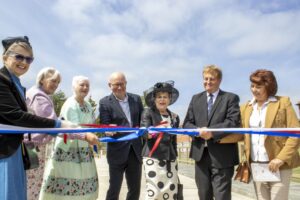
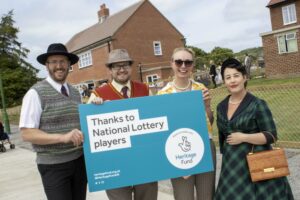
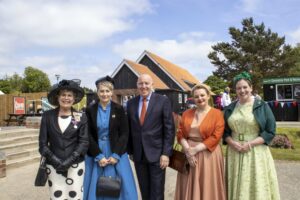
Rhiannon Hiles, Beamish Museum’s Chief Executive, said: “We hope these buildings will give visitors a sense of what life was like on the new estates in a decade which marked a huge shift in the way people lived and worked.
“Huge thanks go to the families and community members who have worked closely with us over the past eight years to develop the buildings within our 1950s estate to really bring them to life – we hope you enjoy exploring them.”
In the 1950s, the North East undertook one of the largest expansions of council housing in Britain. The Rochdale Road houses were chosen to be replicated at the museum following a public vote after we asked people to nominate 1950s-built council housing. Esther Gibbon and her daughter Linda Gilmore were announced the winners out of nine finalists. The family had moved into the house when it was built in 1952. Beamish worked closely with Esther and her daughters Linda and Brenda, gathering memories of their time living in the house. Sadly, Esther died in December 2019 but the museum continued to work with her daughters.
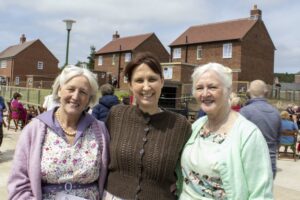
The second semi-detached house tells the story of Polish migration after the Second World War. We have worked with several families on the project, collecting their stories, experiences and objects. They include Ray Malecki whose late father Roman left Poland as a teenager and fought with the Free Polish Forces during the Second World War, later settling in the North East with the support of the Polish Resettlement Corps. Roman trained as a miner and worked in the North East, in Ashington Colliery.
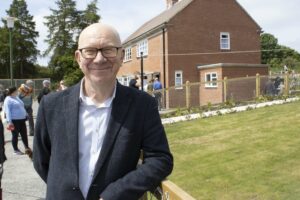
Two police houses and their associated office, from Leam Lane in Gateshead, have been copied to tell the story of 1950s policing and the lives of officers and their families. The museum worked with Councillor John Shuttleworth who, as the son of a police officer, grew up in one of the police houses replicated by the museum. The museum also worked closely with the North East Police History Society (NEPHS).
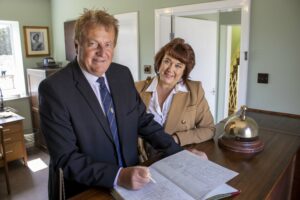
The bowling green and pavilion, which have been replicated from John Whitehead Park in Billingham, will give visitors the chance to try this popular 1950s sport. The John Whitehead Park Bowling Club was built in the early 1950s by Billingham Urban District Council. A men’s club formed in 1953, followed two years later by a women’s club, and the teams later merged to become Billingham Bowling Club, which is still in existence.
Beamish has worked with the club to learn more about its history and the pavilion, as well as speaking to other local clubs, who have all shared their knowledge to help tell the story of bowling in the 1950s. Billingham Bowling Club took part in the first official game on the new green at the opening celebrations.
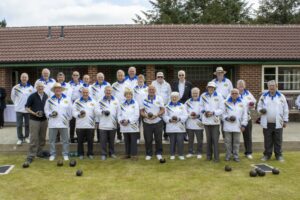
The Remaking Beamish project’s 1950s Town also includes a replica of Leasingthorne Colliery Welfare Hall and Community Centre, Coronation Park and Recreation Ground, Front Street terrace with Elizabeth’s Hairdresser’s, Middleton’s fish and chip shop, John’s Café and a recreation of artist Norman Cornish’s house. Work is underway on a 1950s cinema, toy shop and electrical shop. The Remaking Beamish project also includes 1950s Spain’s Field Farm, transport developments and will also feature an expansion of The 1820s Landscape, which will include examples of early industry, a Drovers’ Tavern and self-catering accommodation.
The new 1950s exhibits are part of the Remaking Beamish project, which is the biggest development in Beamish’s history. Thanks to the money raised by National Lottery players, the Remaking Beamish project was awarded £10.9million by The National Lottery Heritage Fund in 2016.
Helen Featherstone, Director, England, North at The National Lottery Heritage Fund, said: “We are very excited to see another element of the Remaking Beamish project come to life, thanks to National Lottery players. These amazing new exhibits that have been created by working with local people to uncover stories, will give visitors the chance to explore the heritage of the North East and truly understand what life would have looked like in the 1950s.”
Beamish is currently open daily from 10am to 5pm. With the Beamish Unlimited Pass visitors pay once and get 12 months of visits, including daytime events. Find out more at www.beamish.org.uk.
